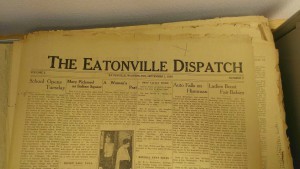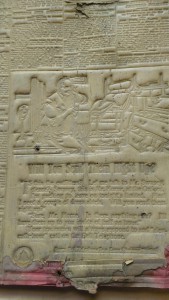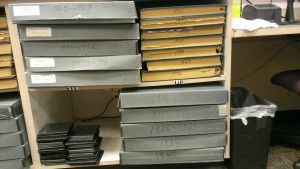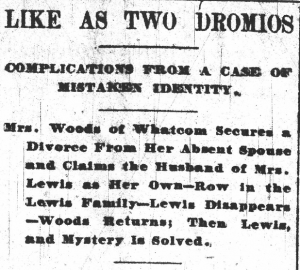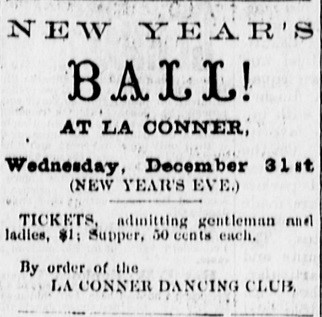From the desk of Steve Willis, Central Library Services Program Manager of the Washington State Library:
“One of the lusty, colorful eras in the history of the Pacific Northwest,” writes Jim Gibbs, “centered around the pelagic sealing industry. It gained great proportions by the 1890’s when every year more than 100 small schooners, propelled only by canvas, set sail from Victoria, B.C. and Puget Sound ports fanning throughout the North Pacific, in the harsh open seas of the Bering Sea, and often into Siberian and Japanese waters.” 
Pelagic sealing was a brutal, dangerous and cruel method of hunting seals for their fur. After decades of hunting by Russian, Japanese, Canadian, and American sealers, the Northern Fur Seal population had declined at an alarming rate. The American government had begun the process of regulating the industry as far as it could in the mid-1890s, so to get around these laws many U.S. sealers worked on Japanese schooners with an international crew, frequently breaking various laws in order to score a large harvest.
The following is a tale of what happened to a group of sealers who gambled and lost when they attempted to harvest seals in a war zone, when men were engaged in killing each other rather than seals. In this case the international battle was the Russo-Japanese War (1904-1905), the first real industrialized conflict in the northern hemisphere in the 20th century.
By coincidence, this seal-hunting episode took place at the same time Jack London’s Sea-Wolf was published, a novel partially based on the life of contemporary sealer Alex MacLean.
The article found at random that led to this tale turned out to be rife with major factual errors, but it did lead to other sources, and they in turn were rife with major conflicting facts. This is an incident that could keep professional historians busy for a long time as they attempt to confirm the data. A little lesson on accuracy and rumors. What follows should be considered a best guess of what happened.
Anyway, here’s the brief news piece that got me started, from the Dec. 6, 1905 Morning Olympian:
SUPPOSED DEAD SAILOR OF ABERDEEN IN RUSSIAN PRISON
Aberdeen. Dec. 5–The sealing schooner Chas. Grant, recently returned to Victoria, B.C. after escaping from Russia through the intervention of the British government, reports that the officers and crew of the schooner Diana, mourned as dead since the summer of 1904, are still alive, immured in a Russian prison on the Amoor.
It transpires that the Danana [sic] did not go down in a storm as was supposed, but was sunk by the Russian cruiser Lena last August, after the removal of the crew. That the Diana was lost and its crew drowned has been so generally accepted that the life insurance of several of them has been paid, and it is said that the wife of one of the crew has married again and lives in Aberdeen.
OK, where do we start? For openers, the Victoria Daily Colonist had reported the lost crew was alive and in a Russian prison about six months before this Dec. 1905 “breaking news” appeared.
Chas. Grant was not a schooner, he was a human being working as a sealer. Along with a fellow Victoria resident named Robert Finlay, they had been part of the crew of the Hokusei Maru, a Japanese sealing ship that had been seized and sunk by the Russian cruisers Gromoboi and Rossia.
Grant and Finlay told reporters they had been kept in a POW camp with 1500 Japanese, including some sealers who had been aboard the Diana. The Japanese prisoners reported to Grant and Finlay that the Diana crew had not perished at sea, and the North American prisoners had been taken to another facility. “Rather odd, isn’t it?,” Finlay told the Bellingham Herald (Dec. 7, 1905), “to be delighted to learn that your friends are in prison?”
The prisoners Finlay was making reference to were identified as Capt. T.R. Thompson, Edward McNeill, George McCamish, Joseph Knapp, and a mysterious character we’ll call Joseph Vollo for now.
Next, the Diana was not really the Diana. The schooner had left the Victoria fleet and was registered in Japan. It was now called the Kyoichi Maru. The schooner flew under different flags, including Norway, Britain, and Denmark, as a blind.
In early August 1904 the Kyoichi Maru crew had somehow gotten into a quarrel with four other schooners as they descended upon Robben Island to slaughter seals at a rookery there. This small patch of land is now called Tyuleniy Island. At the time it was in Russian territory, but from 1905-1945 belonged to Japan. Somehow the four schooners conspired to block the Kyoichi Maru from participating in the carnage, so the ship waited until the others departed and then returned to start clubbing whatever seals were left. On Aug. 16, 1904, after killing over 200 seals (the previous four ships had killed almost 2000 seals each), they were discovered by the Russian auxiliary cruiser Lena (one version says it was the cruiser Gromoboi).
The Kyoichi Maru was then stripped and, depending on what account you believe, was sunk on the spot or scuttled at the mouth of the Amur River. The Japanese crew members were hustled off to a POW camp, but the five remaining crew members were given what could be called in charitable terms, “special treatment.”
These five were held in detention until Jan. 1905, when they were tried in Russian court and found guilty– of poaching, one would guess. They were sentenced to 18 months imprisonment. By the time they were released, Robben Island had become part of Japan.
T.R. Thompson was the main focus of the Russian’s ire. Based in San Francisco, Thompson was well known to his keepers. As the Nov. 29, 1905 Victoria Daily Colonist explained: “The Russians were greatly interested in Capt. Thompson, who was formerly in the employ of the Russian fur company, which leased the rookery on Robben Island, he was mate on the guard steamer Kotick, which was captured by the Japanese lying in Yokohama, when the war began, and while in the employ of the Russian company, he had learned of the customs of the fur company, of how it placed its guards, etc. information, which came useful when he took charge of a Japanese sealing schooner.”
Thompson was given the harshest sentence of the crew. His manacles were welded on and he was kept in chains for months– to the point where he was unable to walk under his own power for a spell. A cartoon he had sketched had somehow made the Russians suspect he was a spy.
Edward McNeill of Victoria had alerted the press that the Kyoichi Maru was not lost at sea when he wrote to his parents in Victoria in early 1905.
Joe Knapp had lived in Seattle and Bellingham prior to this adventure. Possibly born in 1877 in Nova Scotia, Knapp apparently had a second job as a waiter on an Alaska passenger ship during the gold rush. He appears in the Seattle 1897 city directory employed in the occupation of sealer.
“Joseph Vollo” has been described as being from Guam, Spain, or Mexico. His name changes in each news account, but all versions agree he was quite young.
George McCamish, although described as a Canadian by most news articles, was actually an American. He was born in San Rafael, California in 1865. His lineage traces back to early American Scot-Irish heritage and later to possible Mormon pioneers.
McCamish was no stranger to being arrested by the Russians. In 1903 he had been part of a trio convicted and sentenced for poaching seals in Russian territory.
The North American prisoners from the Hyoichi Maru were released in mid-1906, destitute and in broken health. Through the charity of English and German travelers, the crew were able to secure passage from Vladivostok to Kobe.
At this point the fate of “Vollo” vanishes into the haze of history. McNeill, Knapp, and McCamish, after arriving in Japan, joined the crew of the sealing ship Seifu Maru, commanded by Capt. Ritchie. Thompson took command of a new sealing ship, the Aitoku Maru. Later he became the skipper of the Matsu Maru.
Two years later McCamish was aboard the Kinsei Maru, again with Capt. Ritchie (aka Richardson) when the schooner was seized by the US cutter Bear while illegally raiding seals and trading liquor for pelts in the Pribilof Island area. The Kinsei Maru was infamous as a ship filled with desperate characters, almost like pirates, and was nicknamed “The Terror” by Alaska locals. It was even adorned with a paper mache funnel and painted to disguise itself to resemble a revenue cutter. I cannot verify if Knapp was also part of the crew of 30+ sailors.
Ritchie and McCamish were imprisoned in Valdez for a number of months. Ritchie withdrew from sealing after this episode and lived in retirement in Japan.
George McCamish died June 10, 1911 in the Philippines from meningitis.
Ed McNeill joined the crew of the Toyoi Maru, under the command of Harry Jacobson.
As far as the “widow” in Aberdeen, Washington is concerned, I am unable to ascertain the identity of either spouse. If this story is true, then we have the side love interest gone awry to complete a great historical novel.
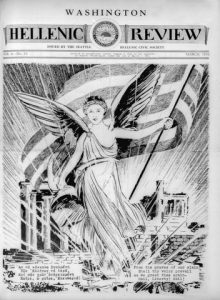 In the early days of the Seattle-based Washington Hellenic Civic Society, little did community citizens know their comings and goings would reach an international audience through the publication of the monthly newspaper, the Washington Hellenic Review.
In the early days of the Seattle-based Washington Hellenic Civic Society, little did community citizens know their comings and goings would reach an international audience through the publication of the monthly newspaper, the Washington Hellenic Review.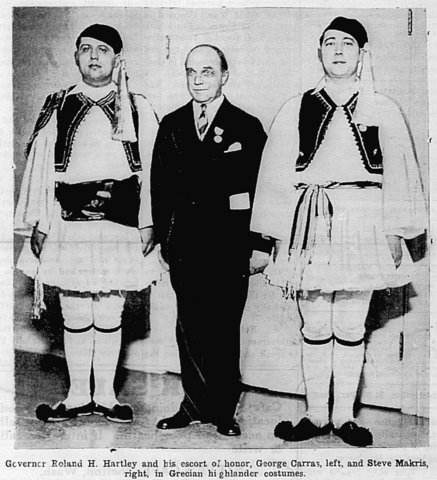 dinners, events of local clubs and societies, and the news of the local parish of St. Demetrios Greek Orthodox Church.
dinners, events of local clubs and societies, and the news of the local parish of St. Demetrios Greek Orthodox Church.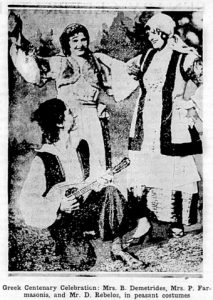 The Hellenic Review was an essential newspaper to the Greek community in Seattle and now the publication is an essential document of Seattle’s local history and to the descendants of Greek immigrants in Washington. The Washington State Library is proud to present online access to the Hellenic Review, one of our most recent titles on the Washington Digital Newspapers website.
The Hellenic Review was an essential newspaper to the Greek community in Seattle and now the publication is an essential document of Seattle’s local history and to the descendants of Greek immigrants in Washington. The Washington State Library is proud to present online access to the Hellenic Review, one of our most recent titles on the Washington Digital Newspapers website.





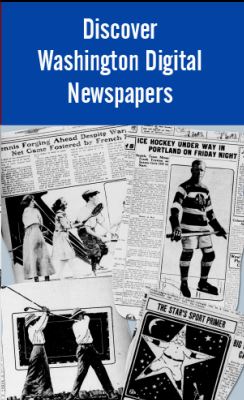
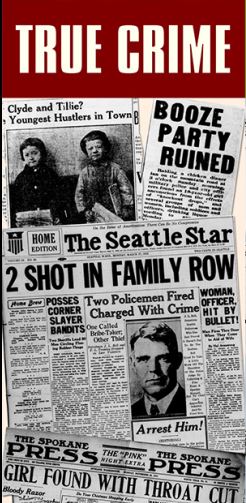
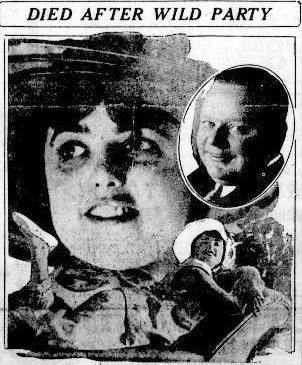

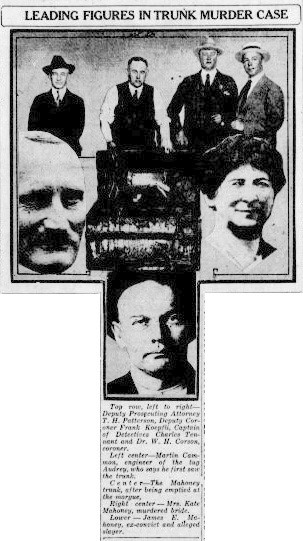

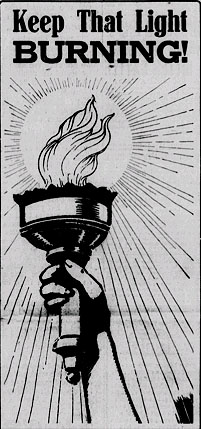 s occur from smudged or blurry originals.
s occur from smudged or blurry originals.
